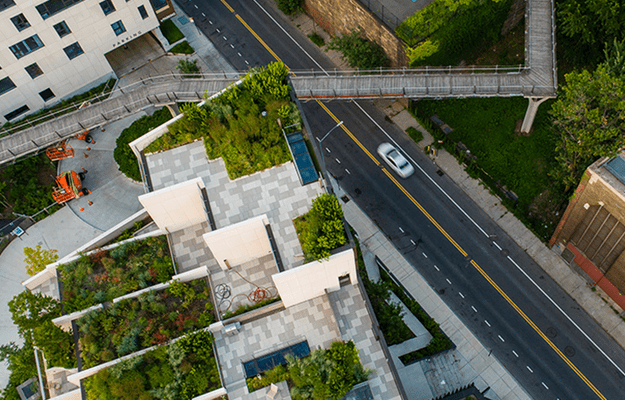
September 24, 2020 - Philadelphia, Pennsylvania: The Rail Park at 1300 Noble Street, unused rail lines turned into a public greenway. (Hope Phillips/Shutterstock)
How Can Greening Cities Predict and Mitigate Future Vulnerabilities to Climate Gentrification?
- Title:
-
They Didn’t See It Coming": Green Resilience Planning and Vulnerability to Future Climate Gentrification
- Author:
-
Galia Shokry, Isabelle Anguelovski, James J. T. Connolly, Andrew Maroko & Hamil Pearsall
- Source:
- Publication Date:
-
2021
Cities invest in green resilient infrastructure, like green roofs, bioswales, and climate-proof parks, to reduce their vulnerability to climate change. However, there is growing concern that green investments may exacerbate gentrification and displacement risks for communities of color who have been long affected by legacies of racial segregation, redlining, municipal abandonment, and the influx of white, wealthier residents. This potential “green gentrification” threatens to exclude these communities from the long-term benefits of green investments.
Little research exists on how much concurrent climate resilience measures, urban revitalization projects, and changes in housing markets may intensify racial inequities and vulnerabilities for displacement. To fill the gap, this study assesses Philadelphia, Pennsylvania’s vulnerability to climate gentrification to evaluate the implications of planned green resilient infrastructure. It also explores how neighborhood development (and redevelopment) and social support resources participate in either advancing sensitivity to gentrification and displacement or, conversely, strengthening adaptive capacity in the face of changing housing markets.
The authors chose Philadelphia because it is a postindustrial, rapidly gentrifying city with an established commitment to urban greening. They conducted a mixed-methods analysis using spatial data on green resilient infrastructure and qualitative interviews to answer two questions: What characteristics, in terms of vulnerability to gentrification, do areas that are planned to receive green resilient infrastructure in the future share? In what ways does green resilient infrastructure exacerbate vulnerability to gentrification for socially vulnerable residents?
The authors built an index focused on three green gentrification risk dimensions: exposure, sensitivity, and adaptive capacity. The index defines sensitivity to gentrification and climate risk by demographic characteristics, such as race, income, and education, and includes compounding neighborhood and structural characteristics of sensitivity, such as urban renewal zoning and real estate development. The authors include adaptive capacity in this study to account for social supports (e.g., community health centers, public-subsidized housing, community-based organizations) that may mitigate displacement risks.
Key findings
-
Though existing green resilience interventions are concentrated in the wealthier and gentrified neighborhoods of central Philadelphia, they are increasing in adjacent neighborhoods that are gentrifying. Neighborhoods experiencing notable increases in green infrastructure are also sites of increased real estate development, economic reinvestment, and growth-driven policies.
-
Green resilient infrastructure projects are spatially correlated with neighborhood investment and redevelopment. Tracts with higher amount of green resilient infrastructure projects had more active construction permits, redevelopment certificates, and historic properties. They were also more likely designated empowerment zones or future opportunity zones.
-
Green infrastructure projects are weakly correlated with other amenities and enhanced social conditions such as waterfronts, cleaned vacant land, lower crime per capita, and improved school performance.
-
Green resilient infrastructure is concentrated in tracts where higher-capacity community-based nonprofits are doing social support and antidisplacement work, but these areas are also sites of intense private development and neighborhood change.
-
Qualitative findings demonstrate that in Philadelphia, environmental nonprofits’ narrow focus on greening may come at the expense of affordable housing advocacy and funding, spurring environmental gentrification.
Policy implications
-
Cities need a variety of social infrastructures to equitably, successfully pursue green infrastructure. Beyond affordable housing, they must provide material support (e.g., community health centers, subsidized child care) for residents with low incomes and residents of color to mitigate gentrification and displacement.
-
While greening is occurring, effort must also be put toward community organizing, education, and advocacy. This not only has potential to bolster movements for affordable housing, community-controlled land uses, and other adaptive capacity resources but also is an important step to taking back money, power, and resources from those that commodify land and housing and consent to speculative growth.
-
Planners working to implement climate resilient infrastructure must also integrate antidisplacement tools (like those noted above) before and from the very early planning stages so benefits can be enjoyed by socially vulnerable residents for as long as possible and without perpetuating unjust and inequitable outcomes.


